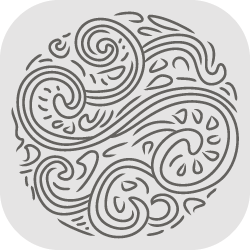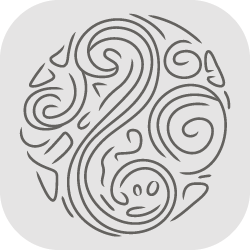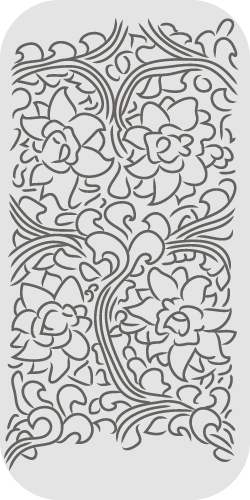- Object Date
- Goryeo 고려 高麗 dynasty (918–1392), fourteenth century
- Medium
- Hanging scroll mounted as panel, framed and glazed; ink, color, and gold on silk
- Dimensions
- Image: 165.5 x 85.5 cm (65 3/16 x 33 11/16 in.)
Overall: 240 x 107 x 5.1 cm (94 1/2 x 42 1/8 x 2 in.)
- Credit Line
- William Sturgis Bigelow Collection
- Collection
- Museum of Fine Arts, Boston
- Accession Number
- 11.6142
- Provenance
Until 1889 at the latest
Koryu-ji 幸龍寺 (temple), Tokyo [1]From at least 1889 to 1911
William Sturgis Bigelow (1850–1926); donated to the Museum of Fine Arts, Boston on August 3, 1911 [2]From 1911
Museum of Fine Arts, BostonNotes:
[1] Note from Arthur McLean to Charles J. Morse dated November 21, 1907: “I had this painting repaired and renovated by our expert here and a most interesting paper was found inserted in the round stick which serves as a roller. It was the memo of the fact that this painting had been repaired about 250 years ago (1642 I believe) at the temple of Koriuji [Koryu-ji] 幸龍寺, Tokyo. This paper gave the names of the different donators and the amounts donated, and was signed by the head priest of the temple. It was with great excitement that I unrolled the note of paper and passed it to one of the Japanese to translate. Even the handling of a piece of paper only 250 years old, which had come from its miniature tomb as fresh and clean and crisp as the day it was laid there, was indeed exhilarating.”[2] Much of Bigelow’s collection of Asian art was formed during his residence in Japan between 1882 and 1889, although he also made acquisitions in Europe and the United States. Bigelow deposited many of these objects at the MFA in 1890 before donating them to the Museum's collection at later dates.
- Remarks
(Undated curatorial remark) The work was acquired by William Sturgis Bigelow in the 1880s. The original Japanese owner is not known even to Kojiro Tomita 富田幸次郎 who published it in 1961.
(Undated Museum of Fine Arts, Boston record) Chinese, Yuan 元: Buddha Sakyamuni [Shakyamuni] expounding the Law of the Perfect Enlightenment to an assembly of bodhisattvas and devas…showing Mongolian influence.
(Okakura [Tenshin] 岡倉天心) Buddha Expounding the Law…A good Buddhist painting of the Gen 元 [Ch. Yuan] dynasty, showing Mongolian influence.
(Letter from Charles J. Morse [1852–1911; Evanston, IL], November 19, 1907) refers to work as “…the Mongolian painting…”
- Published References
Siren, Osvald. Chinese Paintings in American Collections. Paris and Brussels: G. van Oest, 1928. Vol. 4: pl. 160.
Siren, Osvald. A History of Early Chinese Painting. London: Medici Society, 1933. Vol. 2: 124, pl. 101.
Museum of Fine Arts, Boston, and Kojiro Tomita. Portfolio of Chinese Paintings in the Museum (Han to Sung Periods). Cambridge, MA: Published for the Museum by the Harvard University Press, 1938. 1, pl. 2.
Tomita, Kojiro and Tseng, Hsien-chi. Portfolio of Chinese Paintings in the Museum. Boston: The Museum, 1961. Vol. 2.
Museum of Fine Art. Selected Masterpieces of the Museum of Fine Art. 1992. 109.
Kikutake Junichi 菊竹淳一 and Chung Woothak 鄭于澤, eds. Goryeo sidae ui bulhwa 高麗時代의 佛畵 [The Buddhist paintings of Koryo dynasty]. Seoul: Sigongsa, 1997. Vol. 1: 18, pl. 1; Vol. 2: 60.
Kikutake Junichi 菊竹淳一 and Chung Woothak 鄭于澤, eds. Kōrai jidai no butsuga 高麗時代の仏画
[The Buddhist paintings of Koryo Dynasty]. Seoul: Sigongsa, 2000. 18, 412, pl. 1.Gungnip Munhwajae Yeonguso 국립문화재연구소. Miguk Boseuteon misulgwan sojang Hanguk munhwajae 미국 보스턴미술관 소장 한국문화재 [Korean Art Collection at the Museum of Fine Arts, Boston]. Daejeon: Gungnip Munhwajae Yeonguso, 2004. 76–77, 262, pl. 105.
Lippit, Yukio. “Engaku kyō hensō zu 圓覺經變相圖 [Illustration of the Perfect Enlightenment Sutra].” Kokka 1313 (2005): 38–39, pl. 1.
Kang Soyon 강소연. Ireo beorin munhwa yusan eul chajaseo 잃어버린 문화유산을 찾아서. Seoul: Buenlibro, 2007. 208–225, figs. 1, 2.
Gungnip Jungang Bangmulgwan 국립중앙박물관. Goryeo bulhwa daejeon: 700 nyeon man ui haehu 고려불화대전: 700년만의 해후 [Masterpieces of Goryeo Buddhist painting: A long lost look after 700 years]. Seoul: Gungnip Jungang Bangmulgwan, 2010. 32, 286, pl. 7.
Chung Woothak 정우택. “Miguk sojae Hanguk bulhwa josa yeongu 미국소재 한국불화 조사 연구 [Investigation Research on the Korean Buddhist Painting in the United States].” Dongak misulsahak 東岳美術史學 13 (2012): 34–35, fig. 1.
Portal, Jane, Hee Jung Lee, and Suhyung Kim. Arts of Korea. Boston: MFA Publications, Museum of Fine Arts, Boston, 2012. 48–49.
Chang, Qing. “Form and References of the Goryeo Painting of the Rocana Assembly in the Museum of Fine Arts, Boston.” Journal of Korean Art and Archaeology 7 (2013): 8, fig. 1.
Samseong Misulgwan, Leeum 삼성미술관, 리움. Semilgagwi: Hanguk misul ui pumgyeok 細密可貴: 한국 미술의 품격. [Exquisite and precious: the splendor of Korean art]. Seoul: Samseong Misulgwan, Leeum, 2015. 404, pl. 97.
Jahyeon 자현. Bulhwa ui bimil: samguk sidae byeokwa eseo joseon sidae gwaebul kkaji 1,600 yeo nyeoneul ieo on challanhan mideum ui girok 불화의 비밀: 삼국시대 벽화에서 조선시대 괘불까지 1,600여 년을 이어온 찬란한 믿음의 기록. Seoul: Jogyejong chulpansa, 2017. 123–24.
- Restrictions & Rights
- Copyright with museum





















